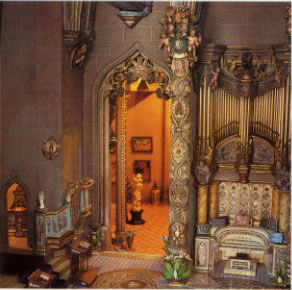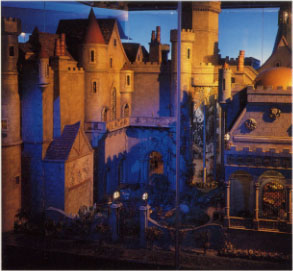Yet only three years later, her career would essentially be finished. While she made the transition to talkies easily and with success, the Depression put her out of business by making the flapper -- her stock-in-trade -- passe.


By 1928, Colleen Moore had reached the top of her profession, having been voted the number one box office attraction in an exhibitors poll two years in a row.
Yet only three years later, her career would essentially be finished. While she made the transition to talkies easily and with success, the Depression put her out of business by making the flapper -- her stock-in-trade -- passe.

But Colleen Moore was one of the lucky ones. At her height she was earning $12,500 a week, and unlike many of her contemporaries, was not spending it on cars, homes, or clothes. Instead, she was spending it on what eventually became her second career: her Fairy Castle.
Her interest in castles and fairies began as a child, when, she writes, as she watched the sky, "I knew that up there on the biggest and fluffiest cloud stood a Fairy Castle and that one day I would find a magic potion as did Alice in her Wonderland. I would be made small enough to visit my dream castle and see the story-book people who lived in the house I had built for them in my mind."
Colleen manifested this fascination by creating paper doll houses, cutting pictures of furniture out of magazines and pasting them onto wallpaper samples. At age two she was given her first doll house, one her parents made from cigar boxes. As she grew older, the doll houses became more sophisticated, but there were still problems: doll house #4 was built in the attic of their home, and grew so large it wouldn't fit through the door when they moved; doll house #5, built of four-ply plywood, warped.
The planning and ideas for castle #8 grew out of a trip to Hawaii, as Colleen's marriage to John McCormick was crumbling. Originally intended to house Colleen's collection of miniatures, the doll house became a labor of love and a challenge for everyone involved in its creation. Having learned from their previous experiences, Colleen's father, Charles Morrison, determined that this doll house would be be engineered to come apart easily (unlike doll house #4), and would be made of aluminum, light and strong (so it wouldn't warp like house #5).
The Fairy Castle, as it came to be called, was given an air of unreality, decorated with the question "What wouldn't people have?" In person the Castle is at once more intimate and more imposing than in photos, and it is very nearly impossible to describe the wonder and sense of awe the Castle and its furnishings evoke.
Work on the castle, begun in 1928, was first completed in 1935, when it made its debut at Macy's. Later the surrounding gardens were completed by the same artisans, and once again the Castle was displayed in department stores around the country for the benefit of children's charities.
In 1936, while taking the Fairy Castle on tour, Colleen met Homer Hargrave, a widower with two children. Hargrave was born in Danville, Indiana, one of three children, and after World War I migrated to Chicago where he worked for H.M. Calvin & Co. According to his son, Homer Hargrave, Jr., Hargrave Sr. claimed that "he never really changed jobs -- the name on the door just changed." H.M. Calvin & Co. eventually became Merrill Lynch, Pierce, Fenner & Bean (later Smith), and Hargrave a partner.
Says Hargrave, Jr., Hargrave Sr. was one heck of a salesman: "Somehow he persuaded [Colleen Moore] to stay in Chicago where it was cold to help him raise his family, and leave California where it was warm." They were married in 1937, and as Colleen describes it "her true happiness began."
Although she concludes her autobiography with the phrase "At last I had become a 'private' person," Colleen was active in a great many Chicago charities. She served on the Board of The Art Institute and The Museum of Science and Industry, as well as maintaining an active role in The Women's Board of Passavant Hospital (later Northwestern Memorial Hospital).
After Hargrave's death in 1964, she was introduced to Michael Kutza by newspaper film critic Ann Marsters. Kutza was working to initiate the Chicago International Film Festival, and found an enthusiastic supporter in Colleen. "She loved the idea of, in a sense, stopping mourning the death of her husband and going back into the visible movie business with the festival." With her support and encouragement, the CIFF premiered in 1965, eventually became the starting point for directors such as Martin Scorcese and Susan Seidelman.
Marsters. Kutza was working to initiate the Chicago International Film Festival, and found an enthusiastic supporter in Colleen. "She loved the idea of, in a sense, stopping mourning the death of her husband and going back into the visible movie business with the festival." With her support and encouragement, the CIFF premiered in 1965, eventually became the starting point for directors such as Martin Scorcese and Susan Seidelman.
Just as she had changed herself from a "movie star" into a "private person," Colleen once again reinvented herself, moving back to California in 1971 and building El Ranchito, a Western-style ranch in the hills of Paso Robles. Yet the Fairy Castle continued to be a constant in her life, one that she shared with granddaughters Alice Hargrave and Kathleen Coleman Mitchell.
The Castle first found its way to The Museum of Science and Industry in 1949, when Colleen originally donated it for display. In 1976, Colleen presided over a ceremony in which she gave the Castle permanently to the Museum. Yet she still remained involved in its upkeep and conservation, and in 1971 published a book on the Castle, "Colleen Moore's Doll House" (Doubleday & Company). With the help of the two eager young assistants, she worked to get the Castle ready. "I helped her in the garden, with all the plants, when they were doing the book. I helped put up all the little apples, and put the little plants in pots. I was 13, and I would go after school and help her," remembers Kathleen Mitchell. "I did that too," laughs Alice Hargrave. "She was very excited about the book, working with the photographer; she was very excited about the whole project." "She'd take us up there when she was going down to check on something," says Mitchell. "She'd take one of us, so we were always pretty involved," an involvement that they still feel keenly.
The two recall the magic that working on the Castle with their grandmother evoked. "She would always see the fairies, and tell us, 'Oh! There goes a fairy now! She always believed in fairies." says Mitchell. In fact, the pillows in the Library, which would get "indentations" due to gravity, was, according to Colleen, proof that the fairies lived there. "I was always trying to see the fairies, looking out of the corner of my eye, hoping to catch a glimpse," says Hargrave.
 Over the years, the Castle has had its brushes with modern life. In 1990, two items were stolen from the Castle, a 3.5 inch silver throne fashioned after England's King Edward the Confessor, and a 4 inch gold and jewel-encrusted candelabra. The items were later recovered in a pawn shop, with the theft traced to a Museum employee. Another time, gang graffiti was discovered spray-painted onto the Castle. After these incidents, the removable plexiglass panels that had previously enclosed the Castle were replaced with tall glass ones that nearly encase the structure.
Over the years, the Castle has had its brushes with modern life. In 1990, two items were stolen from the Castle, a 3.5 inch silver throne fashioned after England's King Edward the Confessor, and a 4 inch gold and jewel-encrusted candelabra. The items were later recovered in a pawn shop, with the theft traced to a Museum employee. Another time, gang graffiti was discovered spray-painted onto the Castle. After these incidents, the removable plexiglass panels that had previously enclosed the Castle were replaced with tall glass ones that nearly encase the structure.
Colleen really threw herself into her projects, and her home in California reflected that. "She really adopted a Western way of life. She built a ranch, but then she customized it, surrounding it with her passions in life, surrounding herself with them," recalls Mitchell. A lover of all things Oriental, Colleen had an exact replica of a Thai temple from the Empress' palace in Thailand built "in the open air, with a breeze going through it," says Hargrave. "The Buddha," however, "didn't want to come to California," she laughs. It kept getting lost, and once it arrived, odd things kept happening." "So she had a Buddhist priest come in and bless it," says Mitchell, after which everything went back to normal.
"She had a real zest for life, no matter what the circumstance... everything was always an experience, always worth trying," says Mitchell. She became an inveterate traveller, taking off at the drop of a hat with close friend Clare Boothe Luce. She caught up with and resumed a decades-old romance with King Vidor, sharing with him a passion for travel and the land. After Vidor's death, she married Paul Maginot, who had built El Ranchito, in 1983.
Colleen remained accessible to film scholars, always happy to discuss her life as a silent star. Yet while her past was a part of her, and she loved to talk about it, she refused to live in the past. The portrait that emerges from her granddaughters is one of a warm, loving, free-spirited grandma, who embraced life and carried no regrets.
Colleen died January 18, 1988 of cancer. Until the end, she refused to acknowledge her illness, and continued to live her life with her characteristic zest for as long as she possibly could.
Even more than her films, her legacy continues to be the extraordinary Castle that she built more than 50 years ago. As Hargrave Jr. recalls, "One day, I happened to hear Clare tell my mother, 'When I die, no one will ever visit my grave. But when you die, Colleen, your doll house will be your tombstone, and 2 million people a year will see it.'"
And so it has.
Weight: 7,000 pounds
Length: 9 feet
Width: 10 feet
Height: 14 feet
Insured value in the 1930s: $435,000
Scale: One inch to one foot
Architect: Horace Jackson
Interiors: Harold Grieve, ASID
Electrician: Jerry Rouleau
Lighting: Henry Freulich
The castle is designed to be dismantled into two hundred peices for packing
Each room is a separate unit, and can be reassembled, including the wiring and plumbing, in one operation.
Many, many thanks must go to Alice Q. Hargrave and Kathleen Coleman Mitchell for their kindness, patience, and time.
Many thanks as well to Homer Hargrave, Jr., for his wonderful quotes and reminiscences.
[Home] [News & Notes] [The Features Page] [The Store] [At the Movies]
[The Calendar] [Silent Era Facts] [Silent Star of the Month]